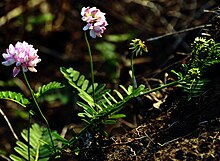Securigera varia
| Crownvetch | |
|---|---|
 |
|
| Crownvetch in bloom | |
| Scientific classification | |
| Kingdom: | Plantae |
| (unranked): | Angiosperms |
| (unranked): | Eudicots |
| (unranked): | Rosids |
| Order: | Fabales |
| Family: | Fabaceae |
| Subfamily: | Faboideae |
| Tribe: | Loteae |
| Genus: | Securigera |
| Species: | S. varia |
| Binomial name | |
|
Securigera varia (L.) Lassen |
|
| Synonyms | |
|
|
Securigera varia (synonym Coronilla varia), commonly known as crownvetch or purple crown vetch, is a low-growing legume vine. It is native to Africa, Asia and Europe and is commonly used throughout the United States and Canada for erosion control, roadside planting and soil rehabilitation. It has become an invasive species in many states of the US.
Crownvetch grows 1 to 2 feet tall and bears small clusters of 1/2-inch pink and white flowers from early summer to late fall. The variety Penngift produces mounds of pink flowers. Crownvetch is a tough, aggressive spreading plant that will crowd out its neighbors in a show garden but is well suited to a sunny bank, where it will grow for decades with little to no fertilizing, mowing, or weeding since the thick foliage prevents weeds from growing amongst it. Its deep, tenacious, complex root system and thick, fern-like leaves provide excellent erosion control where it is used as a ground cover. However, this legume has a very long germination period of about 6 months and does not create full coverage until two or three years later.
Crownvetch is toxic to horses and other non-ruminants because of the presence of nitroglycosides. If consumed in large amounts, it can cause slow growth, paralysis, or even death. However, this is not true for ruminant animals such as cattle, goats, and sheep. These aliphatic nitro compounds are degraded in ruminant digestion and do not affect the animals.
Crownvetch was originally labeled as a poor forage for farm animals but more recently it has been deemed as a good forage when fed as hay to or grazed by ruminants. It consists of 21.7% crude protein and 22.2% crude fibre. In an experiment involving the digestibility of crownvetch in sheep, it was found that the crude protein is 65.6% and the crude fibre is 46.2% digestible which is similar, but slightly less than the digestibility of alfalfa forage. As previously mentioned, this only applies to ruminant animals as it is toxic to non-ruminants.
...
Wikipedia
